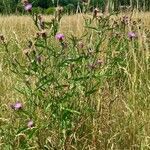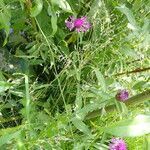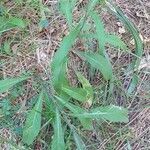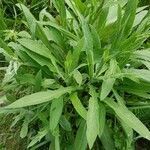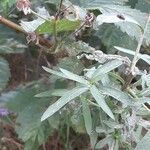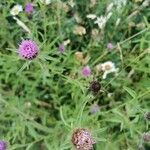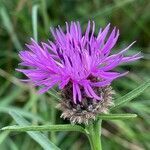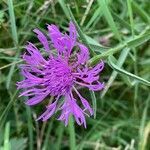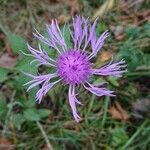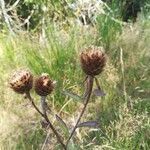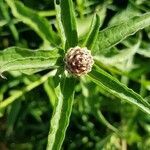Perennial, 2-8 dm, rough-puberulent and sometimes arachnoid when young; lvs entire or toothed, the basal ones broadly oblanceolate or elliptic, entire or toothed to sometimes few-lobed, mostly (1-)1.5-4(-6) cm wide, petiolate, the cauline ones reduced upward and becoming sessile; heads terminating the often numerous branches; invol 12-19 mm, broader than high; appendages of the invol bracts well developed, conspicuously blackish at least in part, the middle and outer deeply and fairly regularly pectinate, the larger ones mostly (3-)4-6 mm long, seldom any of them markedly bifid; fls pink-purple, the marginal ones typically not enlarged; pappus ca 1 mm or less; 2n=22, 44. Fields, roadsides, and waste places; native of Europe, now widely established in s. Can. and n. U.S., s. to Va. and W.Va. July-Oct. Hybridizes with no. 7 [Centaurea jacea L.], producing segregating or stabilized intermediates called C. ×pratensis Thuill., these often approaching C. nigra as to invol, but subradiate as in C. jacea. (C. nigra var. radiata)
Perennial. Stems erect, ribbed, simple or branched above, 30-75-(120) cm tall, glabrescent or sparsely hairy with scabrid, multicellular or appressed cobwebby hairs. Lvs not decurrent on stems, with short scabrid hairs; lower lvs narrowly oblanceolate, simple, dentate to pinnatifid, 10-30 × 1.5-3.5 cm, with triangular-oblong, apiculate lateral lobes; upper lvs pinnatifid or entire, becoming sessile, smaller. Capitula not clustered. Involucre globose, (9)-12-18 mm diam.; outer and middle bracts ovate to broadly elliptic or triangular, not or weakly veined, with cobwebby hairs; appendages erect to recurved, pectinate-fimbriate, covering bracts, membranous, conspicuously narrowed at junction of bract, not decurrent on bract; fimbriae 8-16 on each side, brown, 2.5-4 mm long. Florets pink to purple, the outer ± radiate. Corolla eglandular. Achenes c. 2.5-3.5 mm long, sparsely pubescent; pappus 0-0.5 mm long.
Annual or biennial to 0.8 m high. Stems with short scabrous and adpressed arachnoid hairs; wings absent. Cauline leaves lanceolate to elliptic, entire, green above and below, with short scabrous and longer multicellular hairs; sessile glands present but very sparse. Capitula solitary, pedunculate; involucre broadly ovoid, 10–13 mm diam. at anthesis; median involucral bracts narrowly elliptic, 4–7 mm long, 1.3–2 mm wide, glabrous or with sparse arachnoid hairs; appendages 3.5–5 mm long, dark brown to black, with 7–12 pairs of stiff marginal cilia. Florets all bisexual, purple; tube 7–9 mm long, not glandular; lobes 3.5–5 mm long. Anthers 6–6.5 mm long. Achenes obovoid, 3–3.5 mm long, sparsely tomentose, grey. Longest pappus bristles c. 0.5 mm long, white.
An erect and branching plant that keeps growing from year to year. It grows 1 m high and spreads 50 cm wide. It is hairy and rough to touch. The leaves at the base form a ring and are sword shaped. They have stalks and are usually undivided. The leaves on the stems do not have stalks and are undivided but may have teeth at the base. The flower heads are purple. They have dark brown or black bracts around them. There are comb like sections which cover the base of these bracts.
